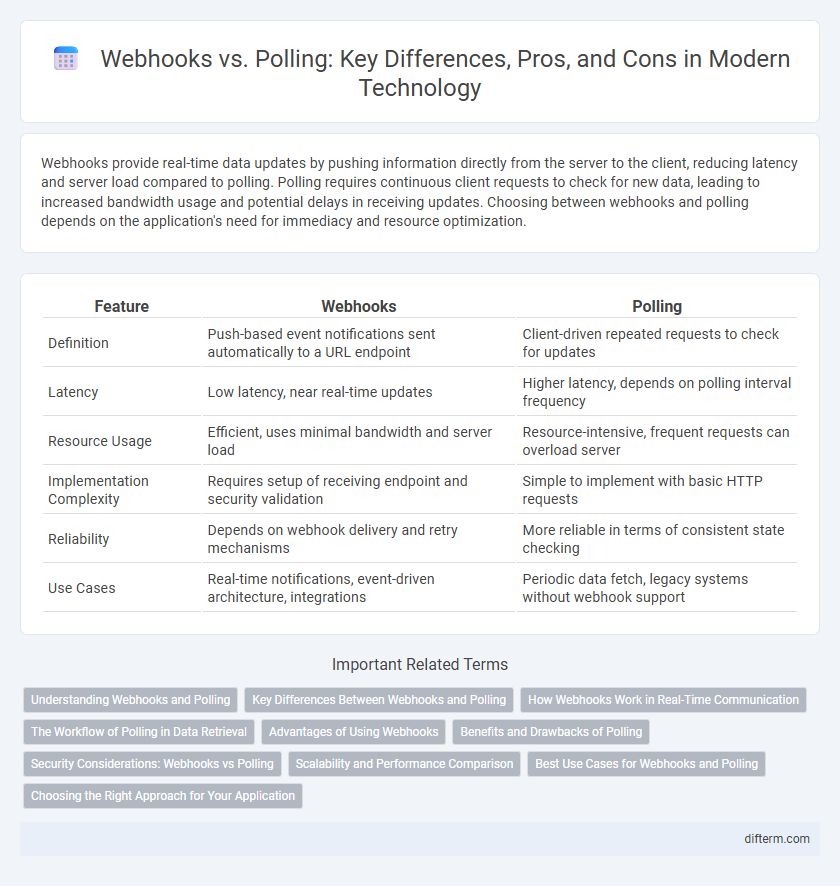Webhooks provide real-time data updates by pushing information directly from the server to the client, reducing latency and server load compared to polling. Polling requires continuous client requests to check for new data, leading to increased bandwidth usage and potential delays in receiving updates. Choosing between webhooks and polling depends on the application's need for immediacy and resource optimization.
Table of Comparison
| Feature | Webhooks | Polling |
|---|---|---|
| Definition | Push-based event notifications sent automatically to a URL endpoint | Client-driven repeated requests to check for updates |
| Latency | Low latency, near real-time updates | Higher latency, depends on polling interval frequency |
| Resource Usage | Efficient, uses minimal bandwidth and server load | Resource-intensive, frequent requests can overload server |
| Implementation Complexity | Requires setup of receiving endpoint and security validation | Simple to implement with basic HTTP requests |
| Reliability | Depends on webhook delivery and retry mechanisms | More reliable in terms of consistent state checking |
| Use Cases | Real-time notifications, event-driven architecture, integrations | Periodic data fetch, legacy systems without webhook support |
Understanding Webhooks and Polling
Webhooks deliver real-time data updates by sending automatic notifications from a server to a client when an event occurs, reducing latency and server load. Polling requires a client to repeatedly request data from the server at set intervals, which can increase network traffic and latency due to constant polling cycles. Understanding these mechanisms is essential for optimizing API interactions and ensuring efficient resource utilization in web applications.
Key Differences Between Webhooks and Polling
Webhooks deliver real-time data updates by automatically sending information to a specified URL when an event occurs, minimizing latency and reducing server load. Polling requires clients to periodically request data at set intervals, which can increase server traffic and delay data reception. The key difference lies in webhooks' event-driven push mechanism versus polling's time-driven pull approach, impacting efficiency and responsiveness in data synchronization.
How Webhooks Work in Real-Time Communication
Webhooks operate by sending automated HTTP callbacks from a server to a client when an event occurs, enabling real-time data delivery without continuous requests. This event-driven mechanism reduces latency and conserves bandwidth compared to polling, which repeatedly queries the server for updates. Webhooks are widely used in applications like payment processing, messaging platforms, and IoT devices to ensure instant response and seamless integration.
The Workflow of Polling in Data Retrieval
Polling in data retrieval operates through periodic requests sent from a client to a server at set intervals, checking for new or updated information. This continuous cycle demands frequent server queries, which can lead to increased latency and higher resource consumption compared to event-driven methods. Efficient polling requires careful timing configuration to balance data freshness against network and processing overhead.
Advantages of Using Webhooks
Webhooks provide real-time data synchronization by instantly delivering event notifications, reducing latency compared to polling intervals. They minimize server resource consumption and bandwidth usage since data is pushed only when changes occur, increasing efficiency and scalability. This event-driven architecture enhances system responsiveness and enables seamless integration between disparate applications.
Benefits and Drawbacks of Polling
Polling enables systems to regularly check for updates, ensuring data synchronization without requiring complex server configurations, but it can lead to increased latency and higher resource consumption due to frequent requests. This method is straightforward to implement and works well for applications with low update frequency or when webhook support is unavailable. However, excessive polling can overload servers and cause unnecessary network traffic, making it less efficient compared to event-driven alternatives like webhooks.
Security Considerations: Webhooks vs Polling
Webhooks provide enhanced security by enabling real-time secure data transmission through encrypted HTTPS connections and authenticating payloads via secret tokens or signatures, reducing exposure to data interception. Polling, while simpler, increases vulnerability as frequent requests expose APIs to potential denial-of-service attacks and require continuous credential validation, increasing the attack surface. Implementing rate limiting and IP whitelisting are critical security practices for both methods to mitigate unauthorized access and ensure data integrity.
Scalability and Performance Comparison
Webhooks offer superior scalability and performance compared to polling by enabling real-time data transfer only when events occur, reducing unnecessary API requests and server load. Polling continuously queries the server at fixed intervals, leading to higher latency, increased bandwidth usage, and potential bottlenecks under heavy traffic. Enterprises leveraging webhooks experience lower infrastructure costs and improved responsiveness, making them ideal for scalable, event-driven architectures.
Best Use Cases for Webhooks and Polling
Webhooks excel in real-time event-driven scenarios like payment processing and live notifications, providing immediate data updates with minimal latency and server load. Polling suits applications needing periodic data checks, such as monitoring systems or APIs lacking webhook support, ensuring consistent data retrieval even without event triggers. Choosing between webhooks and polling depends on factors like response time requirements, server resources, and the nature of the data flow.
Choosing the Right Approach for Your Application
Webhooks offer real-time data updates by pushing information directly to your application, making them ideal for scenarios requiring immediate response and reduced server load. Polling repeatedly requests data at fixed intervals, which can increase latency and resource consumption but simplifies error handling and retry mechanisms. Selecting between webhooks and polling depends on your application's need for latency, scalability, reliability, and ease of implementation.
Webhooks vs Polling Infographic

 difterm.com
difterm.com